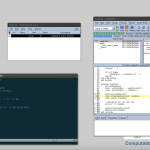
CMS talks: Data at NCI
June 6, 2019 4:19 pm Comments Off on CMS talks: Data at NCIPaola Petrelli (CLEX CMS) talks about accessing climate datasets from NCI

Paola Petrelli (CLEX CMS) talks about accessing climate datasets from NCI

CLEX researchers with the Bureau of Meteorology have created a new 20-year-long regularly updated precipitation dataset for Australia using 50 radar sites. This will allow researchers to examine the climatology of extreme events, follow cloud processes, estimate hail size, determine cloud top height and much more.

Paola Petrelli (CLEX CMS) and Kate Snow (NCI) talk about CMIP6 and Clef, the tool CMS have developed for searching CMIP datasets at NCI.

Claire Carouge (CLEX CMS) gives a brief overview of how to start with WRF at NCI.

The past four months have seen Extreme Rainfall researchers win a slew of awards and produce some important foundational research on storms, hybrid cyclones, and some unexpected influences on extreme rainfall events.

The Climate Variability and Teleconnections Research Program has formed into three separate clusters – SAM, Tropical Variability and Oceans.

When Chilean researcher Dr Erasmo Macaya from Universidad de Concepción and Centro IDEAL stumbled upon foreign kelp washed up on an Antarctic beach, he knew he had found something significant. Research by an international, multidisciplinary team of scientists reveals just how important that finding was.

World-first modelling research– which used several million CPU hours in Australia’s fastest supercomputer, Raijin, and ran calculations non-stop for over a year – has revealed the Southern Ocean mixes water between the depths and surface far more easily than previously thought.

Model crashing halfway through? Don't want to wait in the debugger for hours? Scott Wales explains how to save crash information with core dumps for easier debugging.

Scott Wales explains how to deal with segmentation faults with TotalView.